Picasso's ceramics have evolved from a niche collecting category into a vibrant global market. Collectors worldwide are increasingly drawn to these works, which range from one-of-a-kind sculptures to editioned plates and vases. Once viewed as modest craft pieces, Picasso's ceramics are now recognized as important artworks in their own right, with values spanning a few thousand dollars up to multi-million-dollar auction records. This report provides an expert overview of the market for Picasso ceramics, covering historical context, major types of works, regional trends, recent auction results, and key factors that seasoned and new collectors alike should consider.
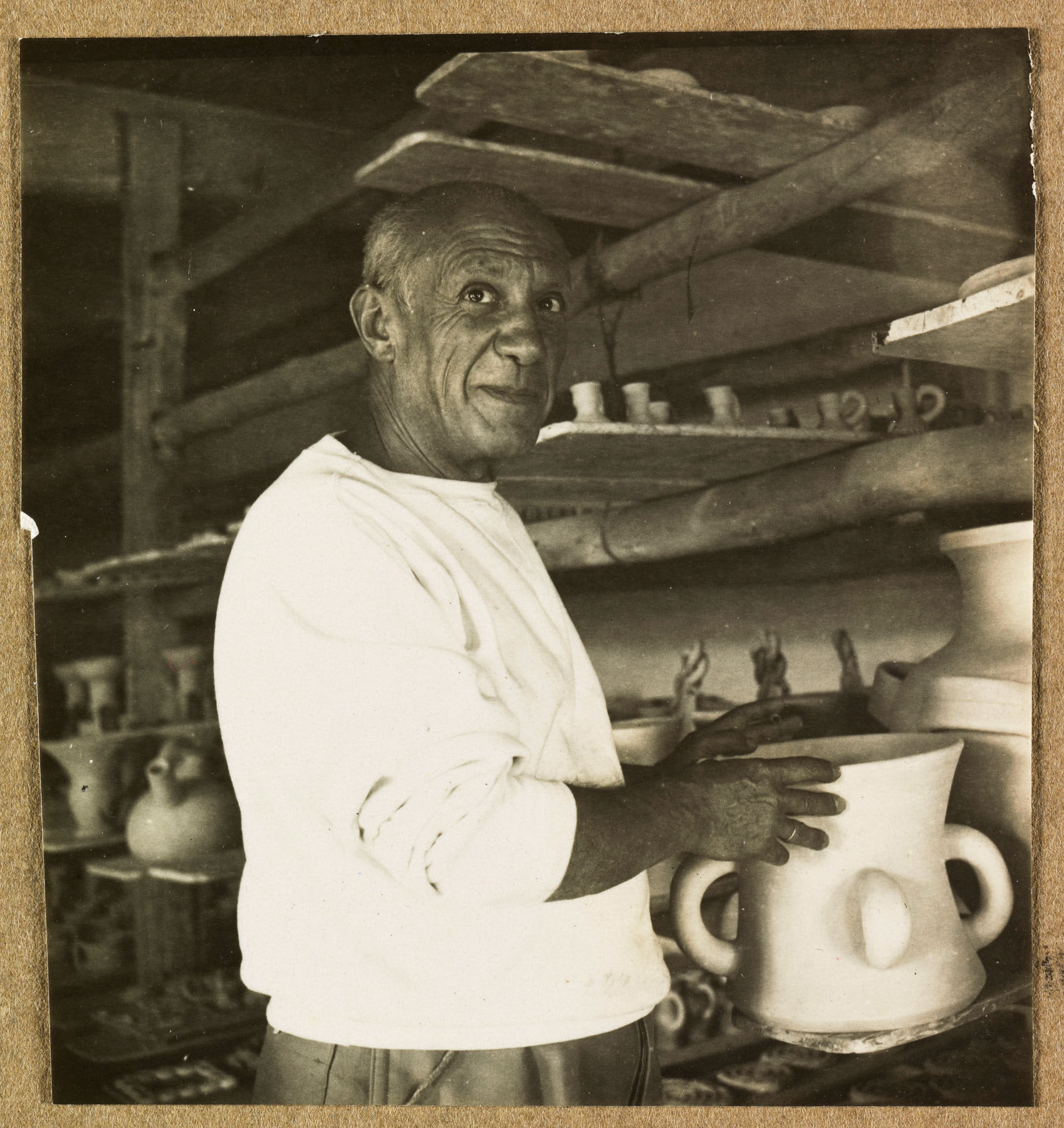
Historical Context and Production Background
In 1946, during a visit to Vallauris in the South of France, Pablo Picasso encountered the Madoura pottery studio run by Georges and Suzanne Ramié. Fascinated by the creative potential of clay, Picasso began a 25-year collaboration with Madoura, transforming the traditional craft of pottery into an extension of his art. Over the next two decades, he produced approximately 3,500 unique ceramic pieces and authorized the Ramié's to create 633 different designs in limited editions. His idea was to "make pieces available to everyone" by producing numerous copies, much as he did with prints. Early on, most editions were sold directly at the Madoura studio at affordable prices, fulfilling Picasso's democratic vision of art ownership.
Picasso's ceramic works were created using a variety of methods. In some cases, he personally hand-painted multiple copies of a design; in others, he carved or engraved an original mold so that artisans could reproduce the image in clay. The Madoura workshop executed editions ranging from 25 to 500 pieces per design, often over a span of years. All authentic Picasso ceramics from Madoura bear identifying marks. Common stamps include Madoura Plein Feu (the pottery's mark), Edition Picasso, and Empreinte Originale de Picasso, each indicating an authorized limited edition. These marks, along with edition numbers and date markings on many pieces, are crucial for authentication and help distinguish original Picasso-sanctioned works from any later copies. (For example, a piece marked d'Après Picasso denotes an authorized reproduction after the artist's design.)
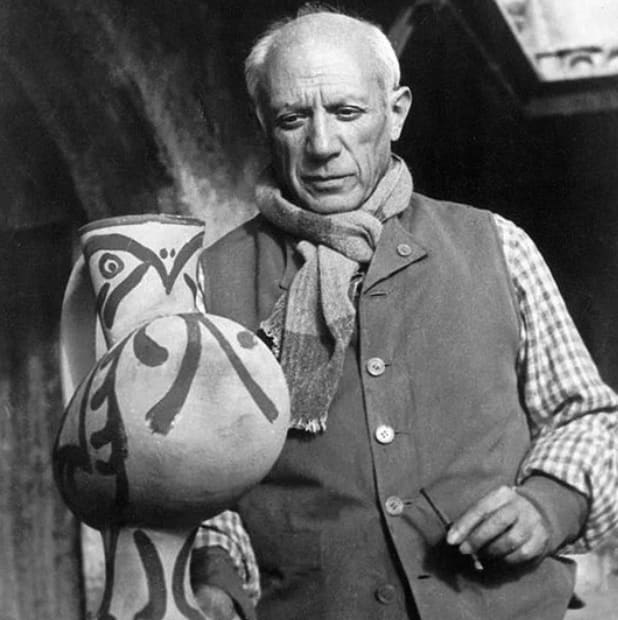
Types of Picasso Ceramics: Unique, Editioned, and Variants
Picasso's ceramic output can be broadly categorized into unique works and editions, with further variations within those categories. Unique pieces are one-of-a-kind objects that Picasso crafted and painted himself - often whimsical sculptures like zoomorphic jugs or hand-formed plates. These unique ceramics carry special allure as they were "modeled by the artist's own hands", imbued with a raw creative energy. They are truly singular artworks, and their rarity makes them highly sought after by top collectors. In contrast, limited editions are designs Picasso created that were produced in multiples at Madoura, each still considered an original Picasso work but one of a series. Edition sizes range widely (25, 50, 100, up to 500), and generally a smaller edition means greater scarcity and higher potential value. For instance, the Grand vase aux femmes voilées (1950) was issued in only 25 copies and became one of the most prized editioned ceramics - one example sold for over $1 million in 2012. In 2023, an editioned pitcher Visage aux yeux rieurs (produced in an edition of 350) astonishingly fetched around $210,000, despite its relatively large edition size, underscoring how iconic imagery can drive demand.
Within the editioned works, there are often production variants. Picasso loved to experiment, so a single design might have multiple colorways or glaze variations. Collectors thus encounter pieces that are "variations - as well as unique works" within the 633 catalogued editions. An example is how a face motif might appear on both a round plate and a rectangular plaque, or how the same owl-shaped vase could have differing paint treatments. These variants add another layer of complexity and interest for collectors, as some versions may be rarer or more desirable than others. It's important to note that all editioned Picasso ceramics, including posthumous editions authorized by his estate, should have the proper Madoura stamps and documentation. Savvy collectors consult reference guides (such as the Alain Ramié catalogue of Picasso ceramics) to verify a piece's edition size, year of conception, and authenticity.
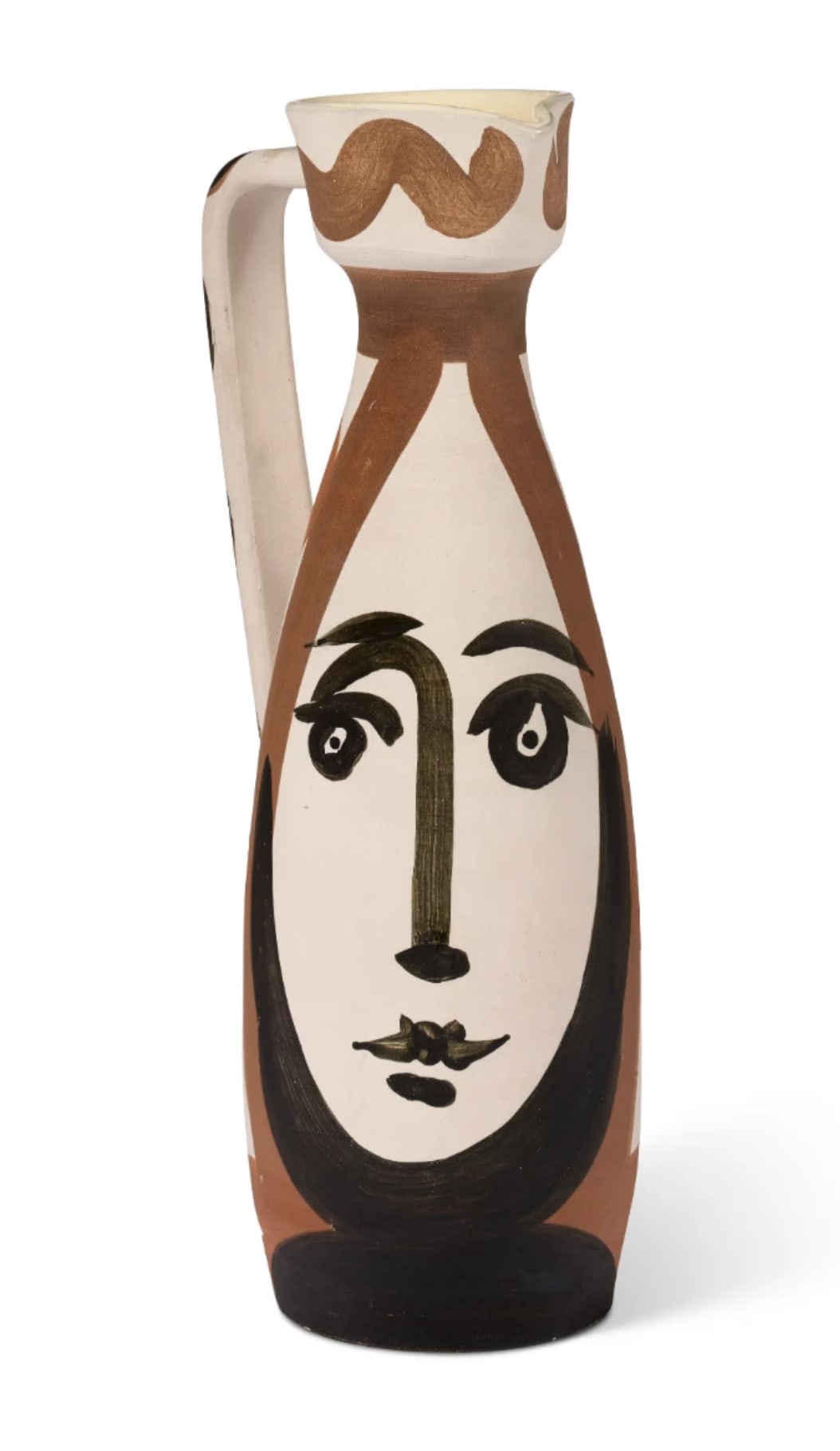
Notable Styles and Motifs in Picasso's Ceramics
Picasso's ceramics encompass a remarkable range of styles, reflecting both his artistic periods and the influence of Mediterranean pottery traditions. Many themes mirror those in his paintings and prints, while others playfully exploit the three-dimensional form of ceramics. One of the most prevalent motifs is the human face. Picasso often transformed utilitarian objects like plates, jugs, and vase-lamps into visages. In some cases, he treated a pitcher's entire form as a sculptural face - for example, a handle might become a figure's ear or a strand of hair. In other instances, he painted a flattened face onto a plaque or plate as if it were a canvas, sometimes framing these ceramic "portraits" as one would a painting. His second wife and muse, Jacqueline Roque, became a recurring subject; Picasso stylized her features on various plates and vases, contributing to a series of works affectionately known as the Jacqueline ceramics.
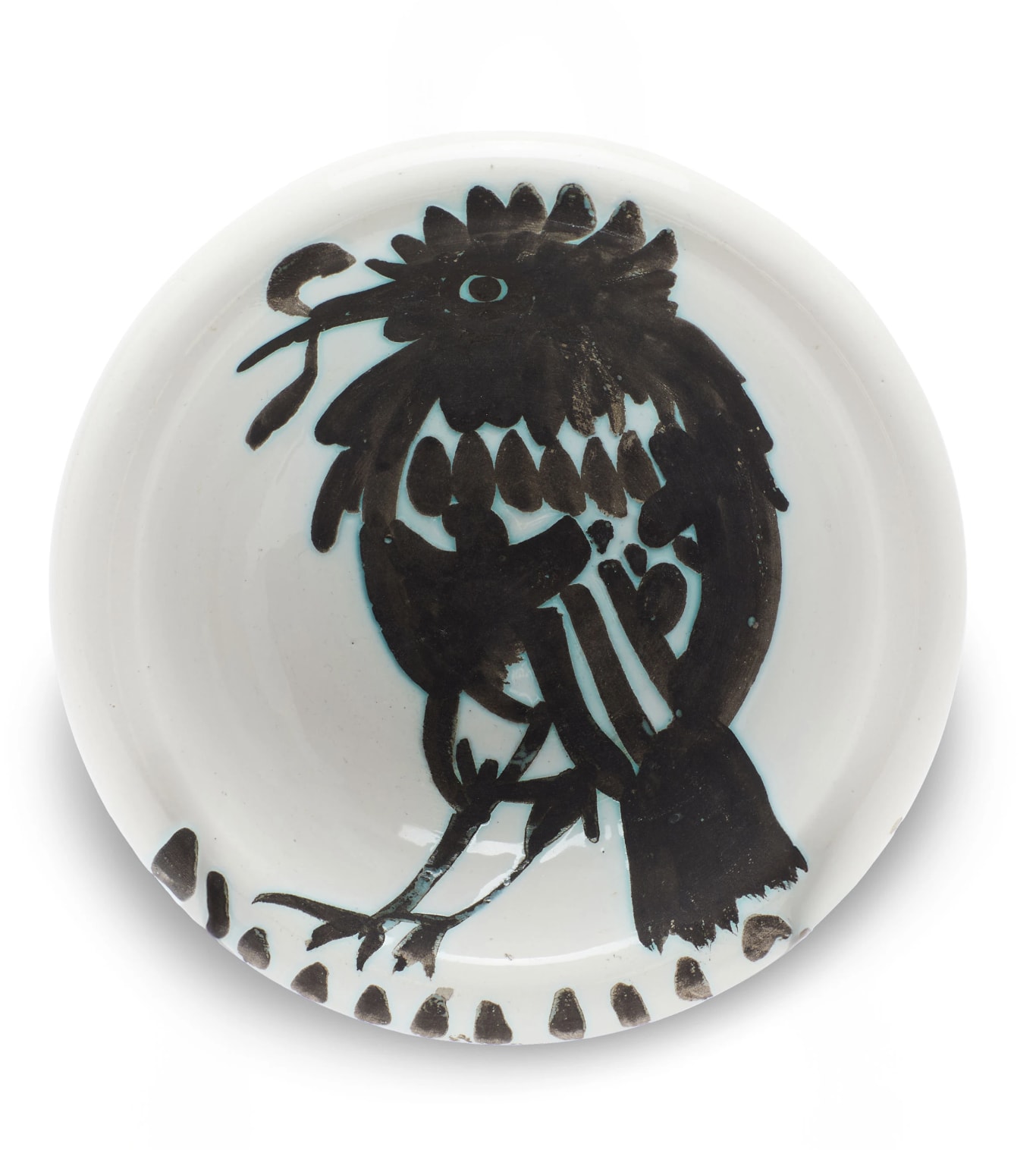
Animal imagery is another beloved category. Picasso was enchanted by the fauna of mythology and everyday life. Perhaps most famous are his owls - a creature he personally kept as a pet and symbolically linked to wisdom and antiquity. He sculpted owl-shaped pitchers and vases, often with whimsical expressions; two unique owl sculptures (Le Hibou) hold auction price records for Picasso ceramics at over $2.4 million. Similarly, Picasso revisited the image of the goat (a symbol of Pan and rustic life) in works like Tête de Chevre de Profil (Goat's Head in Profile) plates. Bulls and bullfighting scenes form another signature series. Having attended bullfights since childhood, Picasso captured the drama of the arena in ceramic form - painting bold black bulls and charging picadors on platter surfaces, or sculpting bull heads on vessels. The round shape of plates and bowls often suggested the bullring itself, a clever integration of subject and medium. Other motifs found in Picasso's ceramics include fish and aquatic life, birds (doves, perhaps a nod to his iconic peace dove), and mythological figures like fauns and centaurs. The glaze styles range from monochrome designs scratched into clay (as in early brown-and-white plates) to brightly painted polychrome glazes and textured surfaces. This diversity means Picasso ceramics offer something for every collector's taste - whether one prefers the earthy, primitive look of his earlier Vallauris pieces or the refined, colorfully glazed editions of the 1960s.
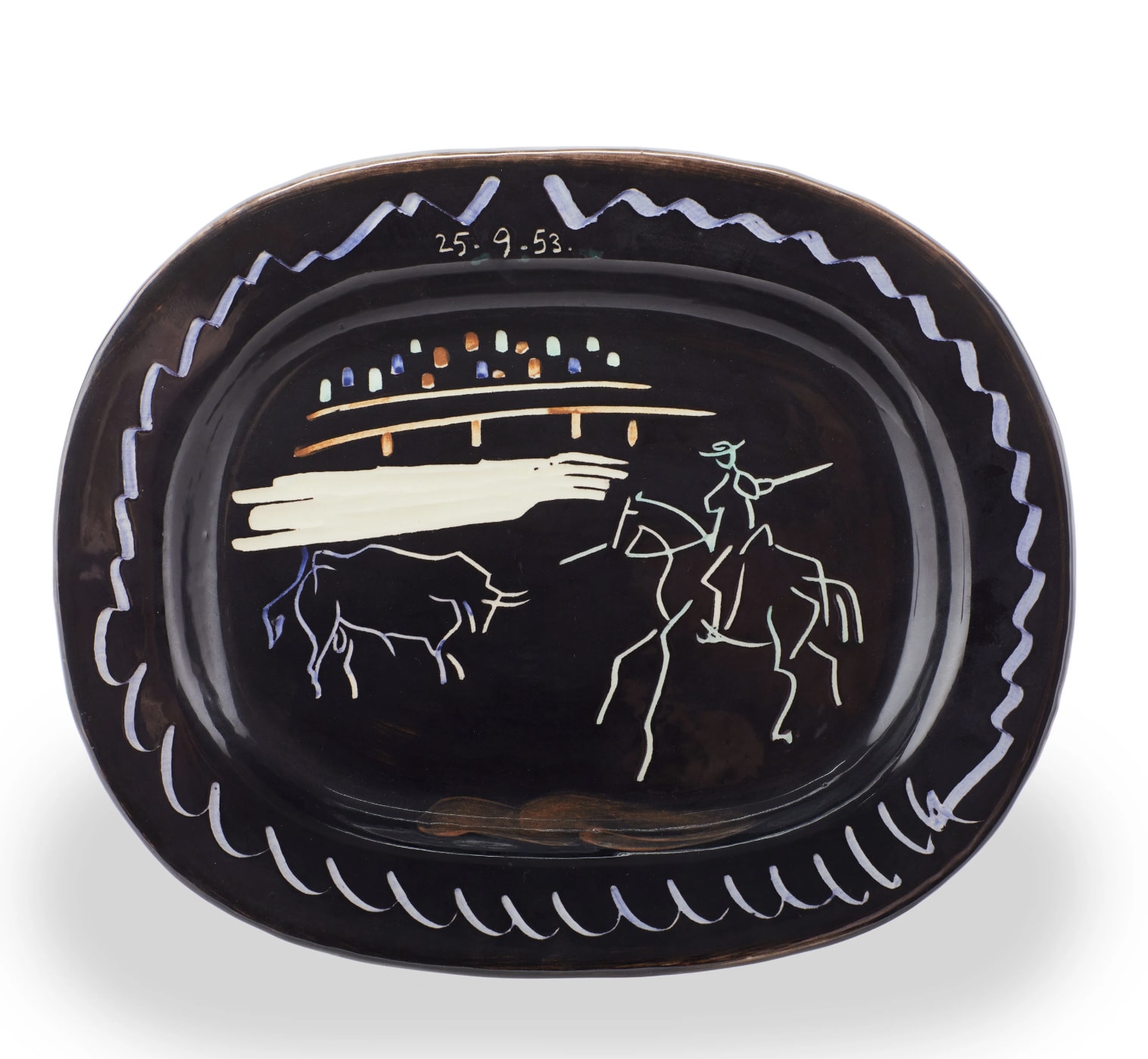
Evolution of Collector Interest
For decades after their creation, Picasso's ceramics were overshadowed by his paintings and sculptures. Many art critics once dismissed them as charming trinkets from the artist's later years. This began to change in the late 20th century as museums and scholars revisited Picasso's "decorative" arts. A turning point came in 1998, when major exhibitions of Picasso ceramics were held at the Metropolitan Museum in New York and the Royal Academy in London, complete with scholarly catalogues. This institutional recognition elevated the ceramics' status, demonstrating that Picasso had "transformed a craft - pottery - into an art". Collectors took note, and what was once a relatively quiet market started gaining momentum.
By the early 2000s, specialized auctions for Picasso ceramics were being held, initially in London and Paris, educating buyers and steadily boosting prices. Longtime aficionados who had collected editioned Madoura pieces since the 1950s-60s were now joined by a new generation of buyers. In 2012, the watershed Madoura Collection sale - where the family of the Madoura founders released over 500 retained pieces - fetched £8 million (about $12.5 million), quadrupling its presale estimate. For many, this auction confirmed that Picasso's ceramics would "never slip off the radar again". A few years later, in 2015, Picasso's granddaughter Marina consigned a trove of unique ceramic sculptures which achieved a 100% sell-through "white glove" sale and nearly $19.4 million in London. By this time, auction houses across the U.S. and Europe were holding dedicated Picasso ceramics sales annually, often with record turnout. The market resurgence was also fueled by prominent gallery shows and publications that further contextualized these works as an integral part of Picasso's oeuvre.
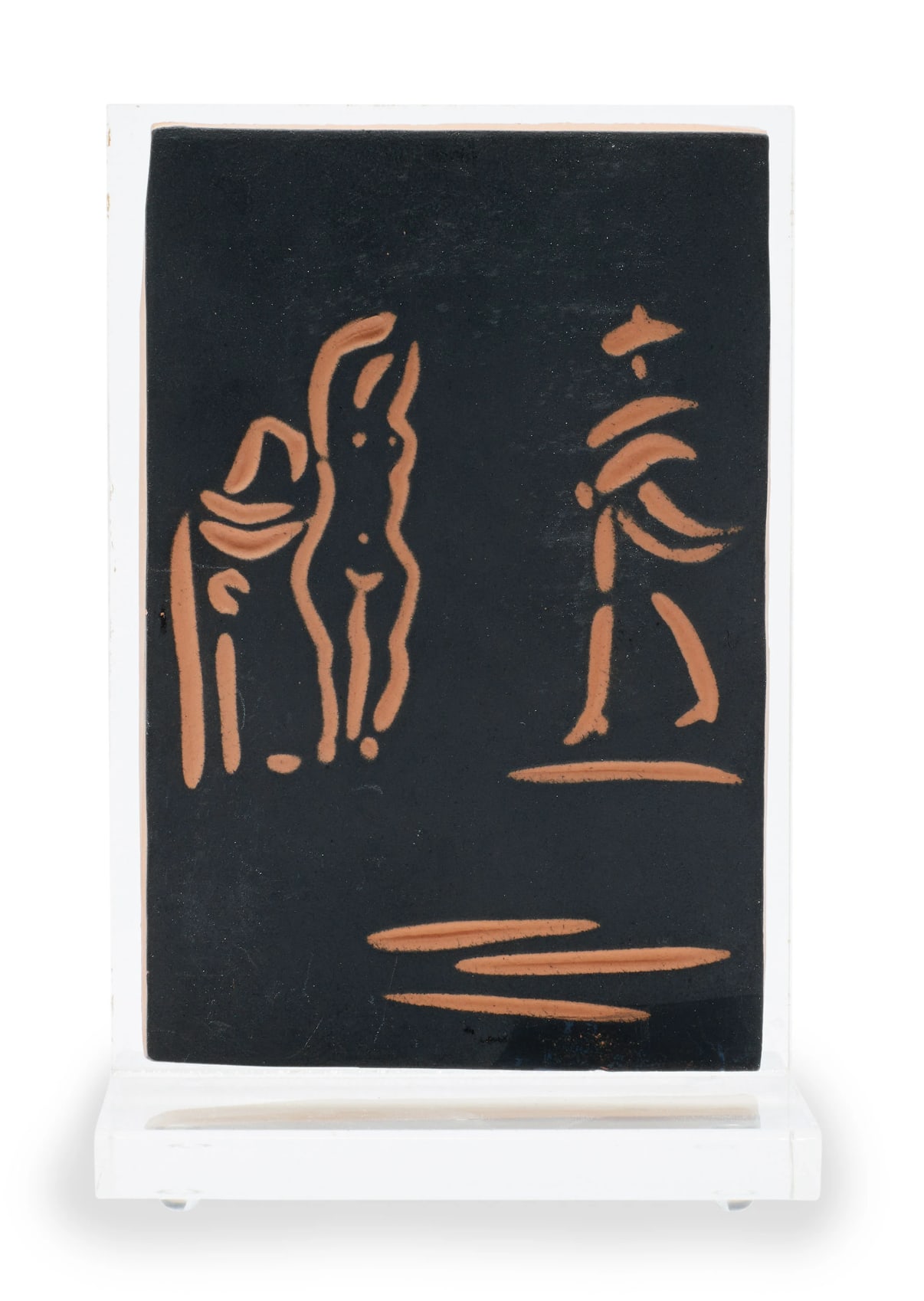
Recent Market Trends and Global Demand
Today the market for Picasso ceramics is truly global. In 2023 alone, nearly 1,500 Picasso ceramic pieces were offered at auction worldwide, with about 75% finding buyers. Major sales in London, New York, and online saw robust participation from collectors in dozens of countries. Notably, one fall 2023 auction in London sold 89 out of 89 lots - a 100% sell-through - totaling over $3 million. Another two sales in 2023 (one in London, one in New York) achieved a combined 96% sell-through for 176 lots, with bidders from 35 countries competing for the pieces. Such metrics indicate strong liquidity and demand across regions.
Europe, where these ceramics originated, remains a core market. France and the UK host frequent sales, and European collectors appreciate the local Vallauris heritage. The U.S. market is equally significant: American collectors have embraced Picasso pottery as a more accessible extension of the artist's work (American auction houses now regularly feature Picasso ceramics, and exhibitions in New York have bolstered interest). In recent years, Asia has also seen a surge of interest. Observers noted that the interest reflects the rarity of Picasso ceramics in Asia and the long-standing appreciation for ceramic arts in that region. Across the board, international collectors are drawn by the chance to own a "Picasso" at a fraction of the price of a painting. Many younger buyers (including millennial collectors) are entering the market via Picasso ceramics, finding pieces in the five-figure range that fit both their budgets and their modern interiors.
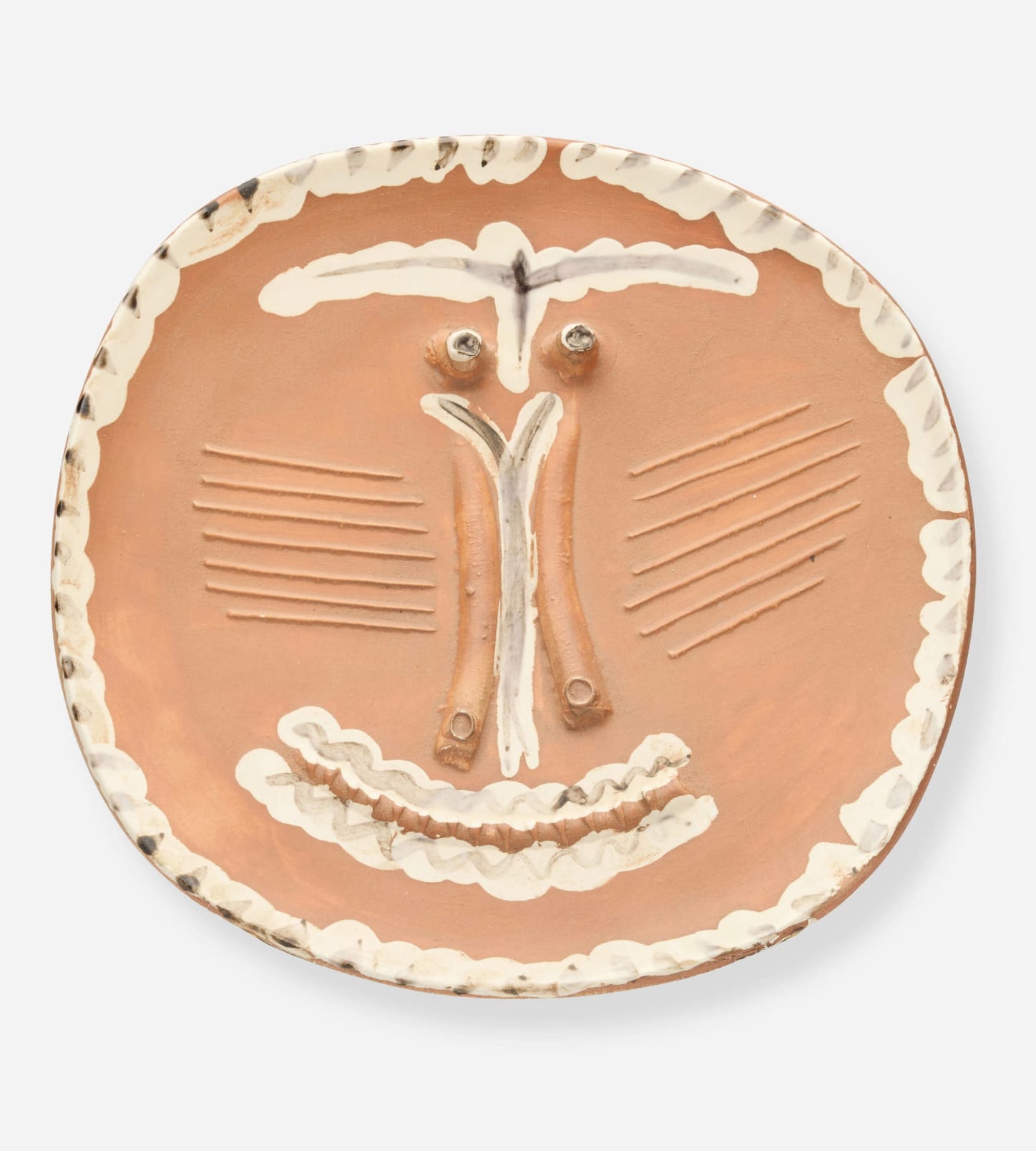
Auction results and values
The price spectrum for Picasso ceramics is wide. At the top end, unique ceramic sculptures have achieved record prices in the mid-seven figures. The current auction record for a Picasso ceramic stands above $2.4 million, achieved by a pair of owl-form sculptures that sold in 2016 and 2018. Not far behind is Picasso's Grand vase aux femmes voilées, an editioned large vase which became the first multiple ceramic to break $1 million at auction. Meanwhile, countless smaller edition pieces trade in the four and five figures. Common designs like Corrida plates, dove dishes, or small decorated tiles can still be found for around $5,000. However, prices have shown a steady upward trajectory. In the early 2000s, one could acquire certain Madoura edition plates for under $1,000, but today those same pieces might fetch $5,000 or more as the market has "revised" their estimates upward due to consistent demand. Even mid-range works have appreciated: plates that routinely sold for $10k-$15k a decade ago might now achieve double that, especially if in excellent condition. The market has proven resilient even in broader art market fluctuations, partly because Picasso's global brand transcends trends. The 2022-2024 period, despite economic uncertainties, saw vigorous sales - a testament to the collectible allure and investment appeal of these ceramics in the eyes of collectors worldwide.
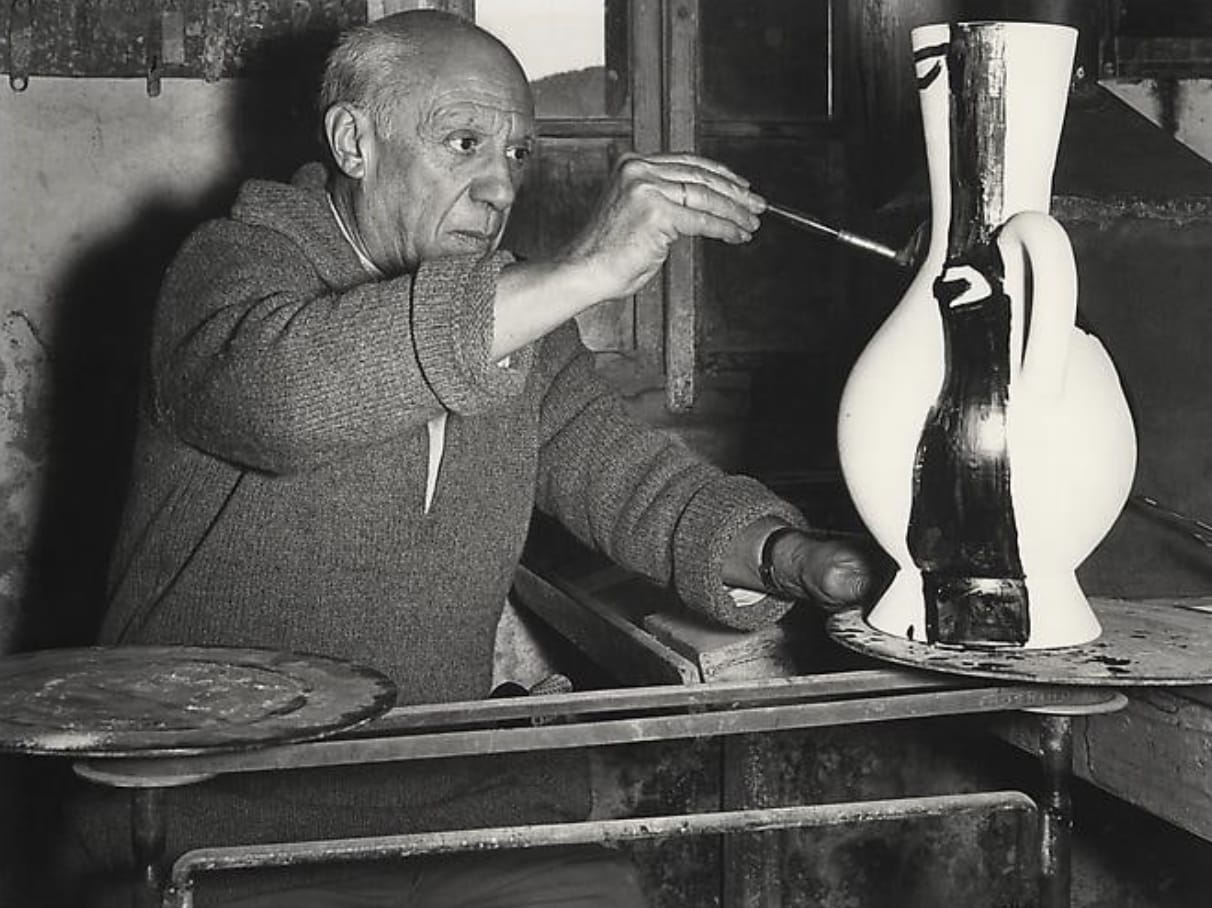
Factors Affecting Value and Investment Potential
When assessing Picasso ceramics as an investment, collectors should consider several key factors that influence value and liquidity:
-
Authenticity & Marks: Authentic Picasso ceramics carry specific Madoura stamps or inscriptions. Verify that any piece has the proper marks (e.g. Madoura Plein Feu, Edition Picasso, etc.) and, if possible, an accompanying certificate or provenance. Fakes are relatively rare but not unheard of - for instance, unauthorized copies lacking the correct stamps can occasionally surface. Ensuring the piece is listed in the accepted catalogue (the Alain Ramié reference for Picasso editions) or vetted by a knowledgeable expert is vital.
-
Condition: The condition of ceramic artworks greatly impacts value. Because these pieces are fragile, many have minor chips, hairline cracks, or repairs. A pristine example will command a premium over one with restoration. It's wise to request a condition report for any higher-value piece. Keep in mind that even at the time of creation, some Picasso ceramics emerged from the kiln with small imperfections or glaze irregularities - these original firing flaws are generally acceptable, but later damage is not. Serious collectors prefer well-preserved works and will pay significantly more for excellent condition. Conversely, an otherwise rare piece in poor condition might sell at a deep discount.
-
Provenance: Provenance can add both legitimacy and value. A piece coming directly from the Madoura collection or Picasso's family (as was the case in some headline-making sales) can instill greater buyer confidence and often attracts competitive bidding. Even a more modest provenance - such as long-term ownership in a notable private collection or inclusion in a published exhibition - can positively influence value. At a minimum, documentation of past ownership and purchase is helpful to have, both for assurance of authenticity and for future resale.
-
Edition Size and Rarity: The size of the edition and the number of surviving examples are core value drivers for Picasso ceramics. Generally, smaller editions (e.g. 25 or 50) are more valuable due to sheer scarcity. A plate from an edition of 500 will be less rare, though certain popular designs in larger editions still see high demand. Sometimes within an edition, specific edition numbers or earlier casts can be valued slightly higher (earlier numbered pieces were often produced closer to Picasso's supervision). Additionally, if a particular design seldom appears on the market - perhaps many are held in institutions or long-term collections - its rarity in trade can boost prices. Savvy collectors track how often a given motif comes up for sale when judging rarity.
-
Aesthetic and Theme: The subject matter and visual appeal of a ceramic also affect demand. Collectors often gravitate toward iconic or particularly charming designs - for example, the charismatic owl and goat sculptures, or plates depicting recognizable Picasso themes like bullfights and faces. If a piece embodies Picasso's unmistakable style (bold lines, inventive form), it may attract broader interest even if not the rarest edition. On the other hand, more obscure or less visually striking pieces might lag in value. Essentially, the market assigns a premium to works that best represent Picasso's genius in clay.
-
Market Timing: Like any art asset, timing can influence sale outcomes. The Picasso ceramics market has generally trended upward, but there are periods of higher activity that a collector might time either entry or exit. Major Picasso anniversary years or museum retrospectives can spur interest (for example, 2023 marked 50 years since Picasso's death, accompanied by many exhibitions and events). Broader economic conditions also play a role - during strong economies, collectors are more willing to invest in art, whereas downturns might soften demand temporarily. However, because Picasso ceramics occupy a somewhat accessible price bracket for a global wealthy collector base, they have shown resilience. Still, if selling, one would prefer a moment when similar pieces are not flooding the market; conversely, if buying, a collector might find opportunities when a larger collection is being sold and competition might diffuse across lots. Keeping an eye on auction trends and results can help inform optimal timing.
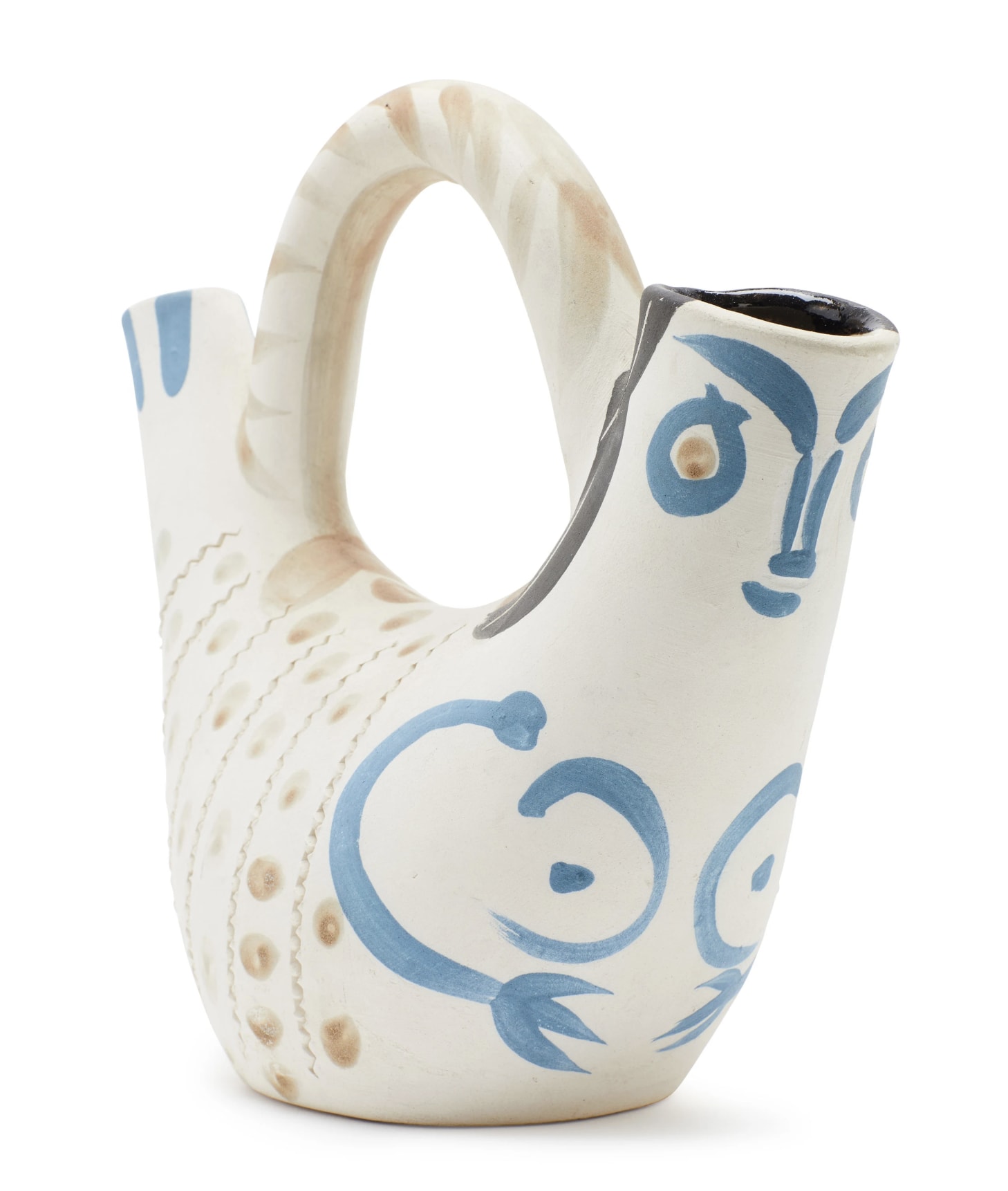
Risks and Opportunities in the Picasso Ceramics Market
Risks: Despite the general strength of this market segment, collectors should be mindful of a few risks. First, as with any collectible, there is the risk of overpaying at a market peak. If enthusiasm for Picasso ceramics were to cool off or if a large supply suddenly hits the market, prices for the more common pieces could stagnate or dip. The vast majority of Picasso's ceramic editions were produced in substantial numbers (hundreds of each design), so the supply is not as inherently limited as, say, his oil paintings. This means that for very widely available designs, future price appreciation might be moderate once most collectors who want one have acquired it. Another risk is liquidity for high-end pieces. While demand is broad, the pool of buyers willing to spend six or seven figures on a ceramic is smaller than those for lower-priced items. Reselling a top-dollar unique piece might take time to find the right buyer or may require consignment to a major auction. Condition risk is also ever-present - ceramics can break if mishandled, potentially resulting in a serious loss. Collectors must take care in display, transport, and insurance of these works. Lastly, forgery or misattribution risk, though relatively low thanks to the Madoura marks, is something to consider particularly in private sales; always ensure authenticity to avoid costly mistakes.
Opportunities: The Picasso ceramics market offers significant opportunities for collectors and investors. These works remain one of the most accessible ways to own a Picasso, which means new collector interest is continually being attracted, refreshing the demand pool. Compared to paintings or even prints, many ceramics are still reasonably priced - a fact that suggests room for appreciation as Picasso's overall market expands. As more collectors in emerging art markets (such as Asia) pursue Picasso pieces, ceramics could see additional upside because not everyone can chase the $100 million paintings, but many can stretch to five or six figures for a striking ceramic for their collection. The sheer variety of Picasso's ceramic output also means collectors can build sub-collections (for example, collecting all the designs featuring owls, or assembling a set of plates from a particular year or theme). Such focused collecting can create its own niche value; if you become a recognized specialist in a certain category of Picasso ceramics, you might be well-positioned to broker sales or lend to exhibitions in the future. Furthermore, as museums continue to embrace Picasso's ceramics (they are increasingly included in Picasso shows and some design museums), the cultural cachet of owning these works grows. Owning a Picasso ceramic is not just owning a decorative object - it's participating in the legacy of one of the 20th century's greatest artists, which is a narrative that can be compelling if one later decides to sell. In summary, the market presents a combination of enjoyment and investment potential: collectors can relish living with a beautiful Picasso piece while also betting on its long-term value trajectory.
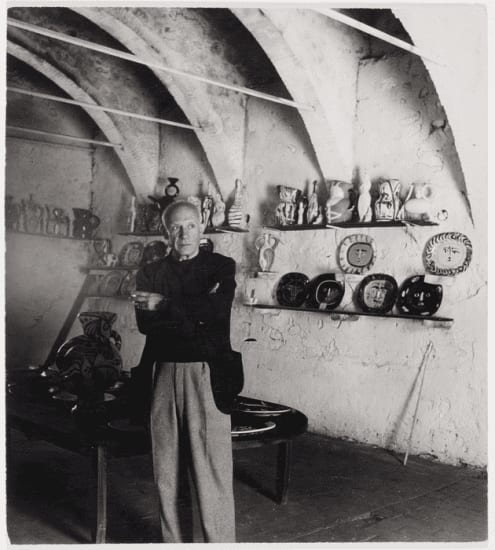
Guidance for Collectors
Navigating the Picasso ceramics market requires a blend of passion and due diligence. Here are some expert tips for collectors at any level:
-
Do Your Homework: Start by studying the field. Familiarize yourself with Picasso's ceramic catalog - which designs exist, their edition sizes, and relative rarity. Read auction catalog notes and collector guides. Knowledge of Picasso's markings and the stories behind certain series (e.g. the Madoura production context) will make you a more confident buyer.
-
Buy What You Love: As with all art collecting, it's wise to acquire pieces that genuinely appeal to you. The good news is Picasso's ceramics span many styles - whether you are drawn to a playful animal figure or a minimalist painted plate, choose works that resonate. This way, if the market fluctuates, you still own something you enjoy displaying. Many collectors fall in love with the "playful tone" of Picasso's pottery and derive great joy from the artworks beyond their monetary value.
-
Verify Authenticity and Condition: Only purchase from reputable sources or sellers who guarantee authenticity. Insist on clear photographs of any stamps or signatures on the piece, and cross-check them with known examples. If possible, obtain a condition report or inspect the piece in person. Even hairline cracks can affect value, and restoration should be disclosed. Remember that perfect examples will always be most coveted by future buyers, so invest in quality when you can.
-
Consider Provenance and Documentation: A provenance tracing back to Madoura or a notable collection can be a tie-breaker between two similar pieces. Whenever you buy a Picasso ceramic, keep any invoices, catalog listings, or certificates - these documents help tell the piece's story. If the piece was illustrated in a book or exhibited, note that as it may enhance prestige.
-
Edition Matters: Be mindful of how edition size and number might affect your piece's desirability. Early numbers from an edition or pieces from smaller runs could appreciate more. However, don't dismiss a larger edition if the imagery is iconic - some widely produced designs are perennially popular. Use edition information as one data point in your decision.
-
Stay Informed on Market Trends: The Picasso ceramic market continues to evolve. Follow auction results (many auction houses publish results online quickly) and observe which pieces are fetching top prices. Note emerging patterns - for instance, if you see a certain motif suddenly becoming the "hot item" of the season. By staying informed, you can time your purchases or sales strategically and identify undervalued opportunities.
-
Secure Proper Insurance and Display: Treat valuable ceramics with care. Ensure you have insurance coverage for breakage and theft - many insurers offer fine art policies that cover ceramics. When displaying your piece, use secure mounts or cases if appropriate, especially for fragile or top-heavy sculptures. Avoid placing valuable ceramics in high-traffic areas or on open shelves where accidents could occur. Proper care will preserve your investment.
-
Consult Experts When in Doubt: If you are considering a high-value purchase or venturing into unfamiliar territory (such as a very rare unique work), don't hesitate to consult an expert or hire a trusted art advisor. Specialists in Picasso's works or modern ceramics can provide insight on fair pricing, authenticity, and even future marketability of a piece. Their guidance can be invaluable, particularly for newcomers.
By following these guidelines, collectors can confidently build a collection of Picasso ceramics that not only holds financial value but also offers rich aesthetic and historical rewards. Picasso himself delighted in the fact that his ceramics allowed more people to live with his art. Today, that delight extends to collectors around the globe who vie for these inventive works of art. With a thoughtful approach, collecting Picasso ceramics can be both a wise investment and a deeply satisfying pursuit, connecting you with the playful genius of Picasso in a very tangible way.
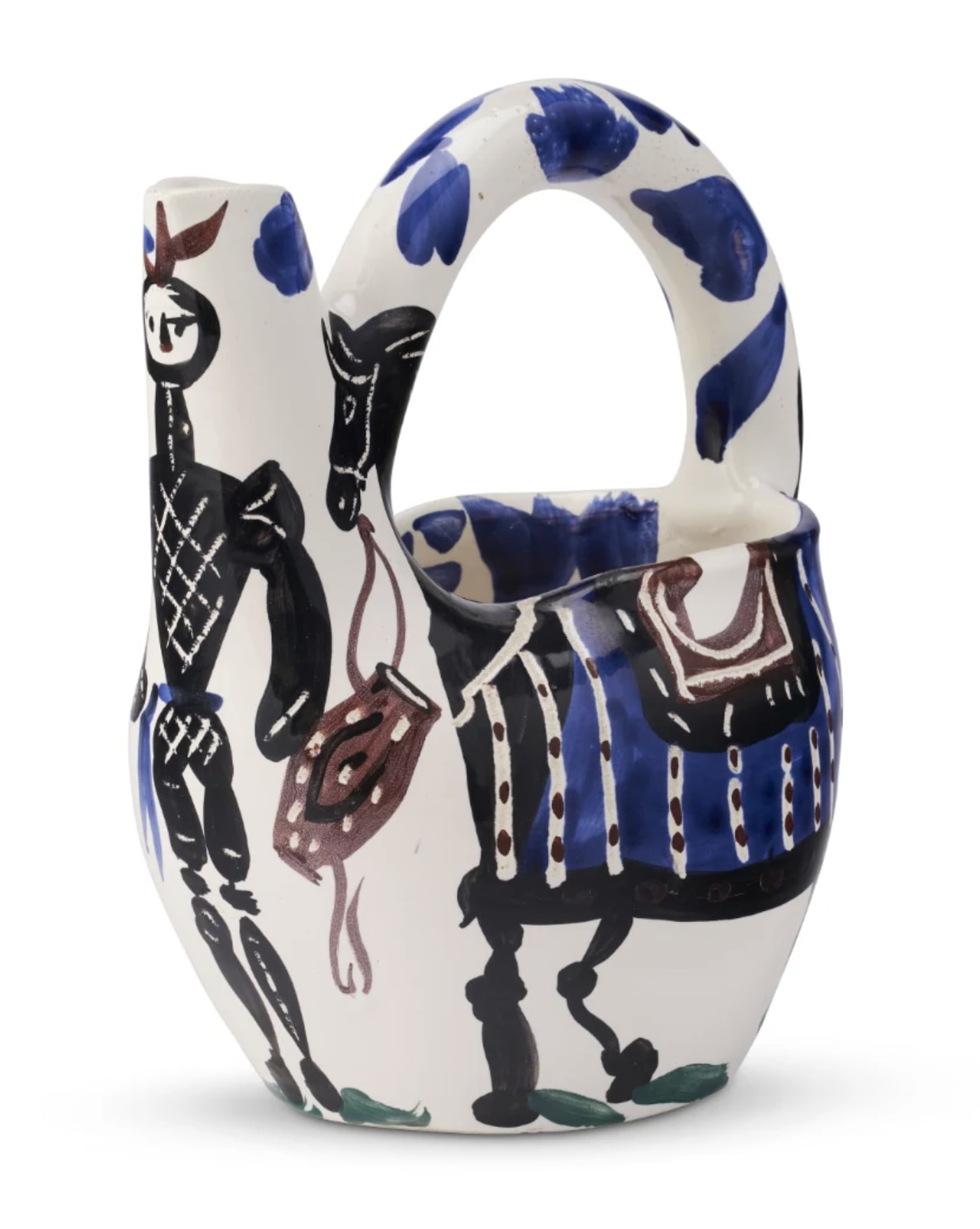
The market for Picasso ceramics has matured into a dynamic segment at the intersection of fine art and decorative art. From their humble origins in a small French pottery studio to record-setting sales in international auction rooms, these works chart an extraordinary journey. A global collector base now appreciates that Picasso's touch on clay is as brilliant as on canvas. Whether one seeks a modest editioned dish or a museum-quality unique sculpture, Picasso ceramics offer a tangible piece of the artist's legacy with the potential for appreciation in value. By understanding the market's history, trends, and fundamentals, collectors can navigate the risks and seize the opportunities this field presents. In the end, collecting Picasso's ceramics is not merely about investment or prestige - it is about engaging with the endlessly creative spirit of Picasso himself, who proved that even clay and fire could bend to his artistic will, leaving us a panorama of works to cherish and collect. Discover Picasso ceramics for sale and contact our New York and London galleries for further information.

